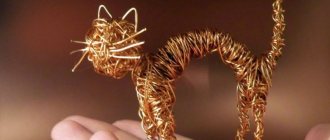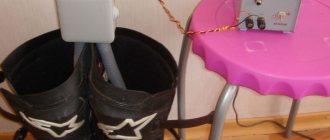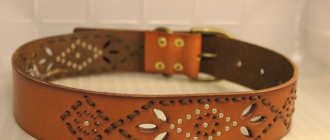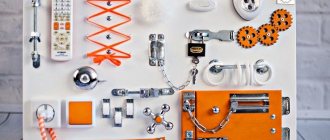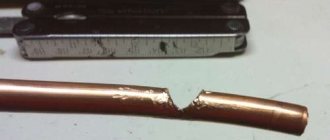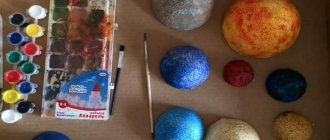Today, stores sell rodent control products that are “exotic” from the point of view of the common man. Such devices include electric repellers that operate on a 220 V network, as well as special electric mousetraps. It is worth noting that electric mousetraps are a more effective means of combating pests such as rodents than, for example, ordinary mechanical analogues. However, such devices in stores are not cheap, so to save money, you can build a simple electric mousetrap yourself, at home using improvised materials.
Dangerous field mouse at home
Although the field mouse is indeed small, it can turn out that the damage it deals is really great. And the point here is not that he feeds on reserves and destroys them, leaving his excrement on them.
It is worth knowing that field mice are often carriers of serious diseases (for example, brucellosis). In addition, rodents in the home can lead to very serious problems.
Mice often make holes by gnawing holes. This means that the building's timber structures are at risk. In addition, they often make holes in the facade, insulation and similar places. Mice have very sharp teeth, so it can make a very deep hole in an instant.
In addition, the smell of these animals is truly repulsive. Therefore, you should protect your home, basement or attic from visiting these aggressors at all costs. In addition, if a situation arises that a mouse has settled in the house, you must immediately begin to fight it.
The main danger lurking in mice
Mice are not just unpleasant neighbors, but also quite dangerous animals for human health. These rodents are natural carriers of microbes that cause diseases such as:
- various lichens and fungal diseases;
- salmonellosis;
- toxoplasmosis;
- leptospirosis;
- rabies;
- tularemia;
- pseudotuberculosis;
- rickettsiosis.
In addition, a mouse can become a source of infection with the rabies virus. The mouse itself does not bite a person, but it can manage to bite a cat that is hunting for it and infect it. Subsequently, the already sick cat attacks people.
The negative aspects of the neighborhood of mice are not limited to those listed, but the examples given are enough to take all measures to remove these rodents.
Effective mousetraps are often relevant not only for private houses in rural areas, but also for residents of apartment buildings in the city. With the onset of cold weather, rodents move to where it is warmer, and channels for laid communications and ventilation shafts make it possible to reach the upper floors. If food leftovers are not removed from the apartment at night, the trash can is left open, and there is general unsanitary conditions, there is a high probability of mice appearing.
Mechanical mousetrap
The most popular rodent control method that has been used for many years is traditional mouse traps. Typically this is a mousetrap made of wood with a spring installed and a hook for bait.
Metal and plastic traps are also now available. When the mouse tries to eat the bait, the trap snaps shut, killing the pest on the spot.
To ensure that a mouse or rat is caught in a trap, you must use the right bait. It could be a piece of bread spread with fat, a piece of cheese, smoked meat or even chocolate. It is also important to monitor rodents and place a trap in their habitat.
But you need to understand that such a trap can be dangerous, especially for pets such as dogs and cats, as well as for small children. This also applies to an electric mousetrap assembled with your own hands.
Advantages of self-made traps
Trade organizations offer many different devices designed for catching small rodents. But self-made traps are still somewhat preferable for a number of reasons:
- Since self-made traps are made from existing materials at hand, they will not require purchasing costs;
- Unlike some types of poisoned baits that cause allergies or have an unpleasant odor, using homemade traps will not require you to leave the house;
- Self-made traps do not pose a danger to small children;
- Possible repeated use without unnecessary costs;
- If it breaks, it's easy to make a new one.
Why make a mousetrap?
Instead of buying typical wooden mousetraps, you can make your own mousetrap. In addition, it will be humane - one that will not harm the rodent. The caught mouse can simply be taken to the forest or to the lake.
This article will talk about how to make a mousetrap at home and what other ways there are to catch harmful rodents.
Methods of catching
There are actually quite a lot of them. It’s worth going to a nearby hardware store and they will offer you a choice of several devices with which you can get rid of annoying rodents.
- A live trap is a kind of humane mouse trap that does not harm the rodent. You can purchase it or make it yourself. A reasonable question arises: what to do next with the captured creature.
- Special glue for rodents.
- Ready-made glue traps.
- Poisons. Of course, the poison works flawlessly. Another thing is where the rodent will die and how to find its body, which will not emit the most pleasant smell.
- Cat. This is not always a reliable method, because some pets tend to quickly leave the place where they saw the mouse.
The worst thing is adhesive backings. The rodent will be alive, but its fur and thin skin on its paws will stick tightly to the composition. Therefore, if you are looking for a humane mousetrap, then this is clearly not your option.
Mouse trap
A mousetrap is an excellent solution for rodent control. This is a very simple metal structure equipped with springs and a latch. When an animal lured by cheese or meat enters and moves the element on which the bait is located, a snap occurs inside. The mouse will not be harmed, so it can be taken to a safe place. Many DIY mouse traps are also very humane. But not all.
Note!
- DIY birdhouse: step-by-step diagrams and drawings for making it yourself. Types of birdhouses and materials + design ideas
- Do-it-yourself landscape design: planning and zoning of the site, selection of decorative elements. New products and design ideas (photo + video)
Do-it-yourself sliding gates at the dacha: options for construction materials, preparation of the territory + step-by-step instructions for doing it yourself
The mouse trap can be double-sided or single-sided. This means that it can have one or two inputs. The design works great not only on mice, it can also be suitable for catching larger pests, such as rats or even martens.
How to install such a mousetrap? You need to find a place near the hole (it can be calculated by the excrement nearby). The clamp should be located approximately 1 meter from the hole.
If you need to catch mice, for example, in a garage or in outbuildings, then you should find a place through which rodents most often walk. The most effective bait is aromatic meat - bacon or a piece of sausage. They will tempt rodents much faster than yellow cheese.
If there is no such trap, then you can make mousetraps with your own hands. The options proposed below are the simplest and most effective.
Basic recommendations for selection
When choosing mouse repellers, you need to pay attention to the following points:
- A high-quality device in a private home has the “Ultrasound Frequency Adjustment” function. More advanced models then regulate the ultrasound automatically. This does not give the rodents the opportunity to get used to it.
- Don't expect one device to protect a large home. Sound waves cannot penetrate upholstered furniture and thick curtains. Therefore, if one device is enough for a small apartment, then for a house you will need at least two, and maybe three.
- Be sure to check the technical specifications of the device you are purchasing. Some models have a specific range that guarantees their trouble-free operation. For example, if you decide to place the repeller in the cellar, it may turn out that it is not suitable for operation at low temperatures.
- There is no need to skimp on the device. Cheap models may have a limited lifespan. In addition, they may malfunction.
What products to use for bait
Now it's time for the bait. You may need to pour a small amount of breakfast cereal into a bottle or simply cut up pieces of bacon. A homemade mouse trap (bottle) is placed next to the mink.
The cardboard can be secured to the floor with duct tape to prevent the rodent from knocking it over. Having smelled the smell, the mouse will run to the bait and easily climb into the bottle, slip through the hole, but will not be able to get out. This is a humane trap - nothing will happen to the rodent, and it can be released outside.
Bottom line: you can make a mousetrap from a plastic bottle with your own hands.
The simplest design
Even a schoolchild can assemble it. To do this, you need to build a box with an open top and without one wall from glue and cardboard. We make a hole in the side walls for a pencil. Now we need a bottle with holes. Bait is placed at the bottom, after which the bottle is fixed in the box. When the rodent gets close to the treasured pieces, the bottle is overweight - and the exit to the outside is cut off. Now the little creature is entirely in your power.
Another option for a mousetrap
Another way to make a mousetrap with your own hands. It also involves using a bottle, but in a slightly different way. A small aluminum or plastic drink bottle, for example 0.5 liters, must be pierced. Two holes are made - in the lid and at the bottom.
Note!
- DIY branch chopper: how to make it from A to Z. 175 photos and step-by-step instructions
- DIY garden paths - varieties of materials. Step-by-step instructions for DIY installation and decoration
Do-it-yourself sauna stove: types of structures and manufacturing materials, technology and stages of work + do-it-yourself construction instructions
You need to pass a small stick through the holes, for example, for a shish kebab. It should be long enough to stick out from both sides of the bottle. The bottle should rotate freely around it.
Plastic container
Today we are looking at the most effective ways to catch a mouse. Not all of them can be considered humane, but no one invited rodents into your home. It is convenient to catch mice using a plastic bucket. To do this, you need to make holes in the container and insert a knitting needle into them. First you need to put a plastic bottle on it. It should spin freely and quickly. The bottle should be coated with beaten egg or porridge. We bring a board to the container, which will serve as a bridge. When the rodent climbs onto the bottle, it begins to spin and he falls into the bucket. You can fill it with water, then you don't have to think about what to do with the mouse.
Installing a mousetrap
Now all that remains is to set the trap. Glue is applied to the middle of the bottle, and a little corn flakes are sprinkled on top of it. They are also good at luring rodents.
The bait prepared in this way is placed on a deep bucket so that the ends of the stick rest on its edges. In addition, a bar is placed on the bucket to create a ladder up to the trap.
Operating principle
The principle of operation is very simple - a rodent, lured by the smell, climbs the ladder to the edge of the bucket. The mouse will try to approach the treat on the bottle.
As soon as the mouse places its paws on it, it will begin to rotate around its axis on the stick. The rodent will fall into a deep bucket from which it will not be able to get out. Thanks to this, taking him outside will not be a problem.
This homemade trap also works on rats, but they are much larger. Some of them, stretching out on their hind legs, will be able to get out of the bucket. Therefore, this mousetrap is more suitable for mice.
Bucket trap
There are many species of rodents that are readily bred by true animal lovers. Among them you can find chinchillas, hamsters, gerbils, guinea pigs and even ordinary mice and rats.
However, what if the latter have moved into the home and are causing damage? Simply put, they should get rid of them. Not only can they ruin half the things in the house with their teeth, but they also sometimes spread parasites and diseases that are dangerous to people and pets.
So, how to deal with uninvited guests? You can try building a simple and humane rodent bucket mousetrap.
Harm from mice to humans
In a relatively short period of time, mice can cause serious damage to stored vegetables and fruits and spoil cereals and pasta. Pests chew wires, make nests in various places and carry dangerous infections. Diseases caused by them include:
- leptospirosis,
- hemorrhagic fever,
- tularemia,
- pseudotuberculosis,
- salmonellosis,
- helminthiasis
These diseases can be transmitted:
- by mouse bites,
- in direct contact with their feces,
- by consuming contaminated food or drinks,
- through the bites of parasites that live on rodents,
- when inhaling air containing infectious agents.
The pests are incredibly prolific - they can bear their first offspring as early as the eighth week after their birth, and replenish the population five to ten times each year. On average, an individual lives for about a year in natural conditions. It is surprising that rodents have not yet overrun the entire planet with such indicators. This does not happen only because the total number of mice is regulated by both natural factors and human intervention.
What you will need
- a bucket (the bigger the better) or a tall aquarium
- a piece of board or cardboard (dimensions no less than 5x20 cm)
- bait (grain, crumbs, flakes, etc.)
It is worth noting that for rats it is better to take a deeper container. A DIY bucket mousetrap should also work for her.
How to lure a rodent
Contrary to popular belief, cheese is not an ideal bait for catching mice. Of course, animals will not refuse a piece of fresh product, but if given a choice, they will prefer seeds or smoked bacon.
Table: which products are suitable as bait
| Salo | Mice really like it. Use fresh, non-rancid product. Stale lard is unlikely to be of interest to animals. |
| Sunflower oil | For bait, an unrefined aromatic product is best suited. Drop oil on the bread crust, this will attract even more pests. |
| Bread and grains | Everyone loves fresh baked goods, and mice are no exception. Grains and bran are somewhat smaller, but are also loved by these animals. Wetting a piece of baked goods with sunflower oil will enhance the effect. |
| Fish | Rodents love fish, and most of all cold-smoked seafood. Such bait must be fresh; mice keenly sense the smell of stale fish and will not go for it. |
| Sausages | This option only works if the product is made from natural ingredients. The presence of flavorings, flavor enhancers, preservatives and other chemicals will not entice pests. |
| Cheese | Regular cheese is not suitable for bait; use a smoked sausage product. Again, the presence of chemical components in the latter will not help in catching uninvited guests. |
To catch mice even more effectively, it is important to know what rodents do not like. Dried cheese, apples, chocolate and dry bread crusts will most likely not work.
Do not trap any products containing preservatives, flavorings or flavor enhancers.
How to do
The bucket is placed in the place where pests are present. Of course, due to the high edges, mice will not jump into it themselves, so it is necessary to create steps that will lead to its sides.
The rise can be made from several boards or bricks. It is best to start the ascent right at the hole from which the rodents emerge, but this is not necessary, because sooner or later they will smell the bait.
At the very top of the ladder, cardboard is placed so that it protrudes 1/3 of its length above the bucket, and a little bait (grain, crumbs) is placed on its “hanging” end. When the pest comes out and tries to get to the bait, it will overweigh the cardboard and get inside the bucket.
If the bucket is high, there is no chance of salvation, but to be on the safe side, you can treat the internal walls with grease. This is what a simple handmade mousetrap looks like.
The trap is disposable, which means that it can only lure one mouse or rat into it. Therefore, it should be checked often, and a rodent caught in this way can be taken somewhere far from where people live.
If there are a lot of pests, then nothing prevents you from making several paths to one bucket. You can watch other handmade mousetraps in videos on the Internet.
Bank and coin
To build a trap, take a base (a book, a wooden or metal plate), a half-liter jar, a coin (50 kopecks) and a treat. Place the prepared base where mice often appear, place the bait on top and cover it with a jar.
Now carefully fix the coin between the neck of the jar and the base. The resulting space is quite enough for a mouse to get through when it comes to the smell of the bait.
When the rodent is trapped, it will definitely touch the coin with its tail, and the jar will fall on top of it. All you have to do is turn the container over and take the uninvited guest out of the house.
But such a mousetrap has one drawback: when it slams shut, the rodent will have virtually no air. Therefore, it is better to place the trap on a board or piece of iron to hear the noise.



